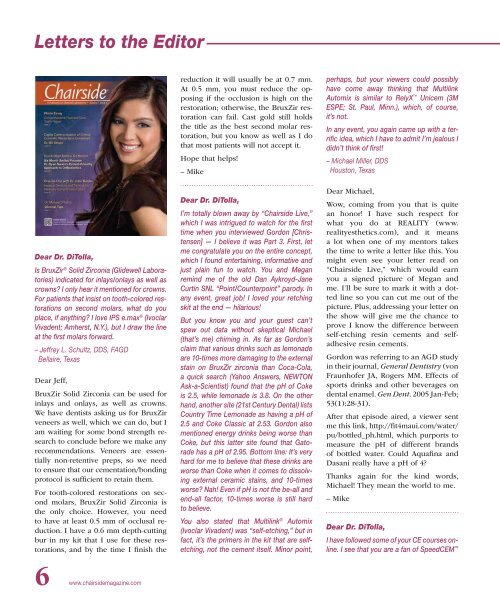PDF Version - Glidewell Dental Labs
PDF Version - Glidewell Dental Labs
PDF Version - Glidewell Dental Labs
You also want an ePaper? Increase the reach of your titles
YUMPU automatically turns print PDFs into web optimized ePapers that Google loves.
Letters to the Editor<br />
Dear Dr. DiTolla,<br />
Is BruxZir ® Solid Zirconia (<strong>Glidewell</strong> Laboratories)<br />
indicated for inlays/onlays as well as<br />
crowns? I only hear it mentioned for crowns.<br />
For patients that insist on tooth-colored restorations<br />
on second molars, what do you<br />
place, if anything? I love IPS e.max ® (Ivoclar<br />
Vivadent; Amherst, N.Y.), but I draw the line<br />
at the first molars forward.<br />
– Jeffrey L. Schultz, DDS, FAGD<br />
Bellaire, Texas<br />
Dear Jeff,<br />
BruxZir Solid Zirconia can be used for<br />
inlays and onlays, as well as crowns.<br />
We have dentists asking us for BruxZir<br />
veneers as well, which we can do, but I<br />
am waiting for some bond strength research<br />
to conclude before we make any<br />
recommendations. Veneers are essentially<br />
non-retentive preps, so we need<br />
to ensure that our cementation/bonding<br />
protocol is sufficient to retain them.<br />
For tooth-colored restorations on second<br />
molars, BruxZir Solid Zirconia is<br />
the only choice. However, you need<br />
to have at least 0.5 mm of occlusal reduction.<br />
I have a 0.6 mm depth-cutting<br />
bur in my kit that I use for these restorations,<br />
and by the time I finish the<br />
6<br />
www.chairsidemagazine.com<br />
reduction it will usually be at 0.7 mm.<br />
At 0.5 mm, you must reduce the opposing<br />
if the occlusion is high on the<br />
restoration; otherwise, the BruxZir restoration<br />
can fail. Cast gold still holds<br />
the title as the best second molar restoration,<br />
but you know as well as I do<br />
that most patients will not accept it.<br />
Hope that helps!<br />
– Mike<br />
Dear Dr. DiTolla,<br />
I’m totally blown away by “Chairside Live,”<br />
which I was intrigued to watch for the first<br />
time when you interviewed Gordon [Christensen]<br />
— I believe it was Part 3. First, let<br />
me congratulate you on the entire concept,<br />
which I found entertaining, informative and<br />
just plain fun to watch. You and Megan<br />
remind me of the old Dan Aykroyd-Jane<br />
Curtin SNL “Point/Counterpoint” parody. In<br />
any event, great job! I loved your retching<br />
skit at the end — hilarious!<br />
But you know you and your guest can’t<br />
spew out data without skeptical Michael<br />
(that’s me) chiming in. As far as Gordon’s<br />
claim that various drinks such as lemonade<br />
are 10-times more damaging to the external<br />
stain on BruxZir zirconia than Coca-Cola,<br />
a quick search (Yahoo Answers, NEWTON<br />
Ask-a-Scientist) found that the pH of Coke<br />
is 2.5, while lemonade is 3.8. On the other<br />
hand, another site (21st Century <strong>Dental</strong>) lists<br />
Country Time Lemonade as having a pH of<br />
2.5 and Coke Classic at 2.53. Gordon also<br />
mentioned energy drinks being worse than<br />
Coke, but this latter site found that Gatorade<br />
has a pH of 2.95. Bottom line: It’s very<br />
hard for me to believe that these drinks are<br />
worse than Coke when it comes to dissolving<br />
external ceramic stains, and 10-times<br />
worse? Nah! Even if pH is not the be-all and<br />
end-all factor, 10-times worse is still hard<br />
to believe.<br />
You also stated that Multilink ® Automix<br />
(Ivoclar Vivadent) was “self-etching,” but in<br />
fact, it’s the primers in the kit that are selfetching,<br />
not the cement itself. Minor point,<br />
perhaps, but your viewers could possibly<br />
have come away thinking that Multilink<br />
Automix is similar to RelyX Unicem (3M<br />
ESPE; St. Paul, Minn.), which, of course,<br />
it’s not.<br />
In any event, you again came up with a terrific<br />
idea, which I have to admit I’m jealous I<br />
didn’t think of first!<br />
– Michael Miller, DDS<br />
Houston, Texas<br />
Dear Michael,<br />
Wow, coming from you that is quite<br />
an honor! I have such respect for<br />
what you do at REALITY (www.<br />
realityesthetics.com), and it means<br />
a lot when one of my mentors takes<br />
the time to write a letter like this. You<br />
might even see your letter read on<br />
“Chairside Live,” which would earn<br />
you a signed picture of Megan and<br />
me. I’ll be sure to mark it with a dotted<br />
line so you can cut me out of the<br />
picture. Plus, addressing your letter on<br />
the show will give me the chance to<br />
prove I know the difference between<br />
self-etching resin cements and selfadhesive<br />
resin cements.<br />
Gordon was referring to an AGD study<br />
in their journal, General Dentistry (von<br />
Fraunhofer JA, Rogers MM. Effects of<br />
sports drinks and other beverages on<br />
dental enamel. Gen Dent. 2005 Jan-Feb;<br />
53(1):28-31).<br />
After that episode aired, a viewer sent<br />
me this link, http://fit4maui.com/water/<br />
pu/bottled_ph.html, which purports to<br />
measure the pH of different brands<br />
of bottled water. Could Aquafina and<br />
Dasani really have a pH of 4?<br />
Thanks again for the kind words,<br />
Michael! They mean the world to me.<br />
– Mike<br />
Dear Dr. DiTolla,<br />
I have followed some of your CE courses online.<br />
I see that you are a fan of SpeedCEM
















